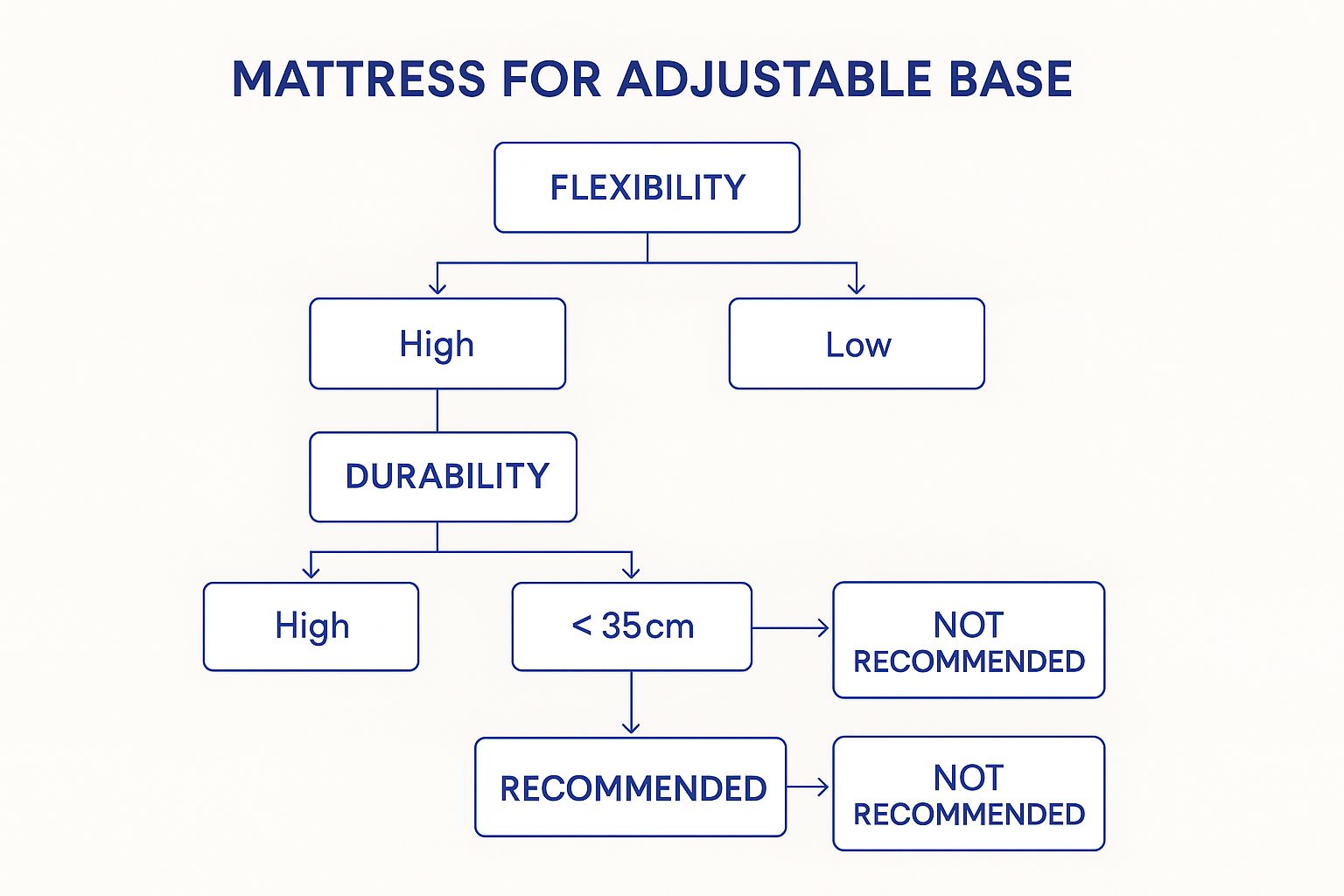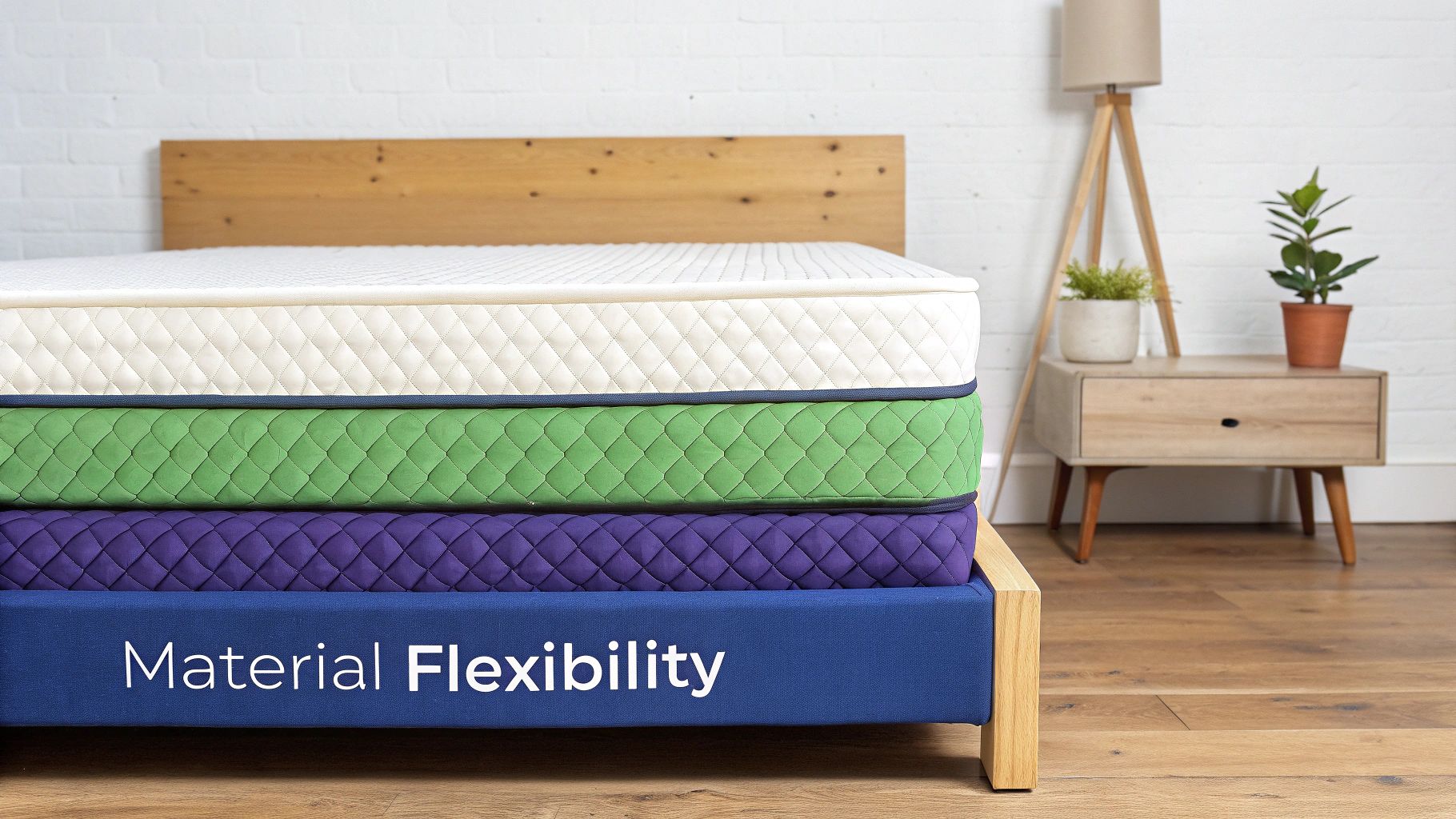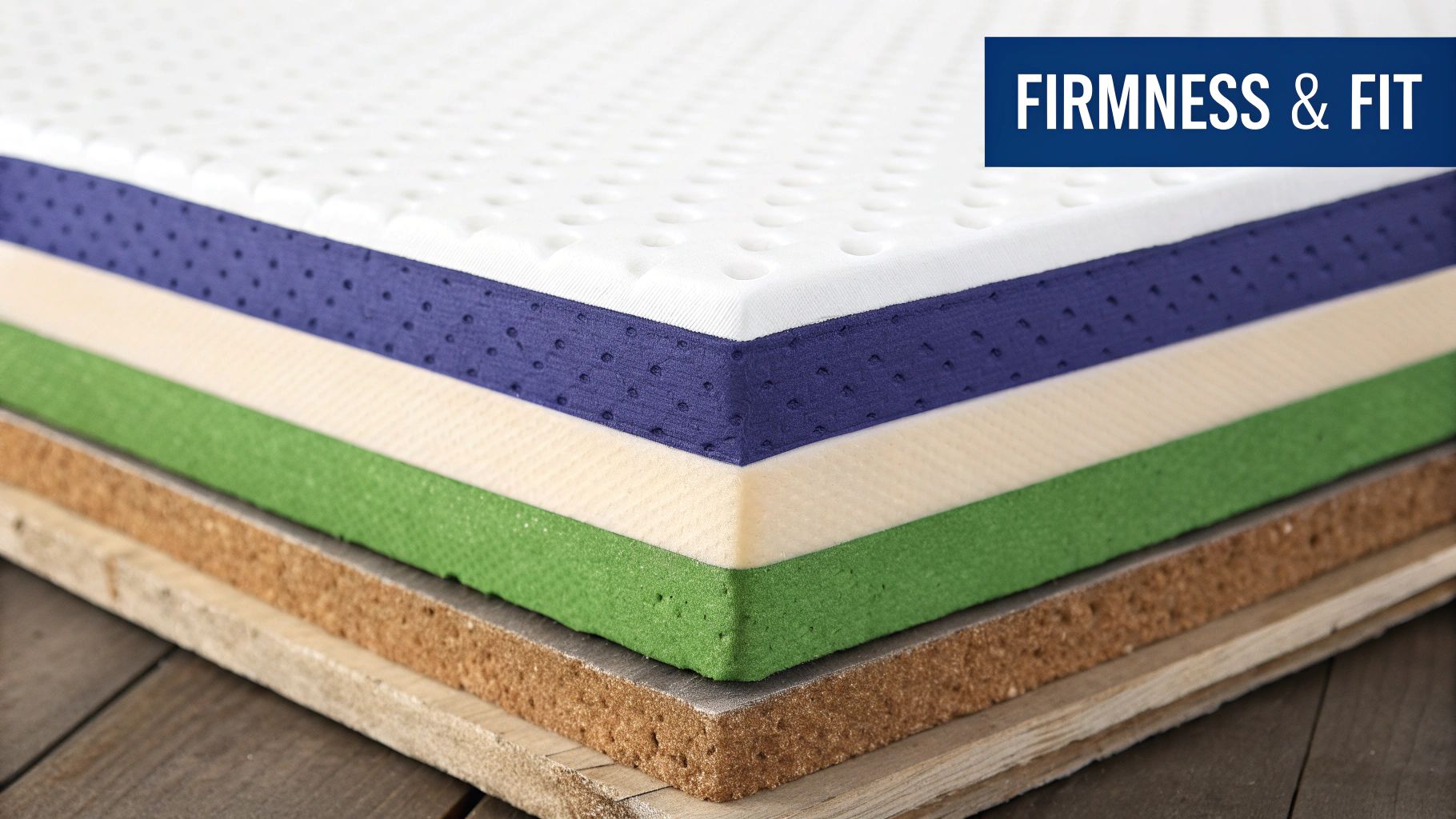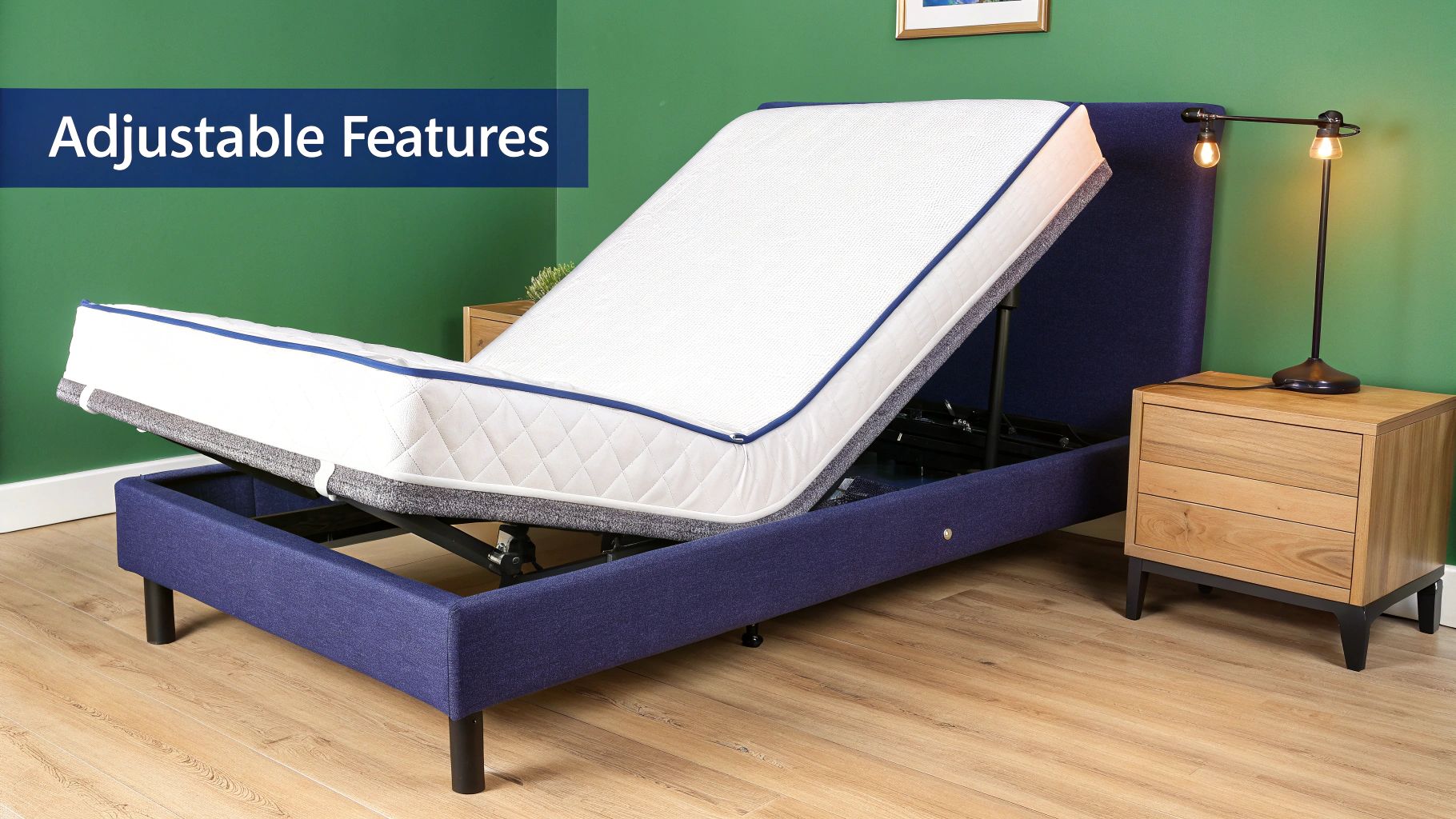So, you're upgrading to an adjustable base? Brilliant move. It's a game-changer for sleep quality and comfort, but it's only half the puzzle. The mattress you pair with it is just as crucial, and nailing that combination is everything.
You need a mattress that's flexible enough to move with the frame, durable enough to handle daily adjustments, and not so thick that it fights the base. For most Kiwis, this means a memory foam, latex, or a well-designed hybrid mattress is your best bet.
Why Your Mattress Choice Is So Important
Think of your adjustable base and mattress as a team. If they don't sync up, the whole system fails. A poor match won't just feel uncomfortable; it can damage your new mattress and put unnecessary strain on the base's motor over time.
Compatibility isn't just a "nice-to-have"—it's a must.
An adjustable frame puts a mattress through far more stress than a standard flat base. It needs to bend and flex on demand, all while supporting your body in elevated positions. If the mattress isn’t built for that kind of movement, you're heading for trouble.
The Pitfalls of a Bad Match
Choosing an incompatible mattress can seriously undermine your investment. For instance, a traditional innerspring mattress with interconnected coils is simply too rigid. It will literally fight the movement of the base, creating awkward lumps and painful pressure points that ruin your comfort.
Over time, this mismatch can lead to real issues:
- Permanent Creasing: Foam layers can develop deep, irreversible creases right where the bed bends, creating uneven spots and ruining the support.
- Damaged Springs: The coils in older-style innerspring beds can get bent out of shape or even break under the stress of constant flexing.
- Loss of Support: When the mattress can’t contour properly to the base's new shape, gaps can form between you and the mattress. This completely defeats the purpose of the base’s ergonomic benefits.
This simple decision tree lays out the essentials: flexibility, durability, and thickness are the three pillars of a compatible mattress.

As you can see, the ideal mattress ticks all three boxes—it needs to be highly flexible, very durable, and stay under 35cm thick.
Choosing a compatible mattress isn't just a recommendation; it's a necessity for protecting your investment and unlocking the full potential of your adjustable sleep system.
This isn't just a niche trend anymore. Here in New Zealand, the beds market revenue for 2025 is projected to hit around NZD 27.92 million, with adjustable bases taking a bigger slice of the pie each year.
A lot of that growth comes from New Zealand’s aging population, which now makes up about 16-17% of the country. People are catching on to the real health and lifestyle benefits these beds offer. For a more detailed look at what to consider, check out our guide on how to choose the perfect mattress in New Zealand.
Comparing Mattress Materials for Flexibility

When you're pairing a mattress with an adjustable base, what’s on the inside truly counts. In fact, it's the single most important factor. Some materials are naturally flexible and ready to move, while others are just too rigid and will fight the frame every step of the way.
Let's break down the best—and the worst—options for your new setup.
Memory foam is a top contender for a good reason. Its whole purpose is to mould and flex, which makes it a perfect match for an adjustable base. The mattress moves effortlessly with the frame's every articulation, so you get consistent, reliable support without the mattress fighting back.
Imagine you're a side sleeper struggling with a sore shoulder. With a memory foam mattress on an adjustable base, you can lift your head and feet just slightly. The foam will perfectly contour to your body in this new position, taking the pressure off your shoulder while the base provides that crucial ergonomic lift.
The Champions of Flexibility
Memory Foam: As we've touched on, its ability to bend and conform is second to none. It’s brilliant at distributing your weight evenly and absorbing motion, meaning you get the full pressure-relieving benefits of any position your base can create.
Latex Mattresses: Latex is another fantastic choice. It's naturally springy and incredibly durable, so it can bend and flex repeatedly without breaking down. Unlike memory foam, latex has a bit more bounce to it, which some people find more comfortable for moving around.
Hybrid Mattresses: These can offer the best of both worlds, but there’s a critical catch. A hybrid mattress only works if it’s made with individually pocketed coils. Because these coils move independently, the mattress can bend smoothly along with the base.
It’s interesting to see how preferences in New Zealand are shifting. The overall mattress market saw a 16.2% decrease in 2024, but this really points to a move away from traditional, one-size-fits-all models. People are now looking for specialised sleep solutions, and a quality bed for an adjustable base is high on the list as we prioritise support for issues like chronic pain. You can read more on the New Zealand mattress market trends and insights.
The One to Avoid: Traditional Innersprings
A traditional innerspring mattress is, without a doubt, the worst choice for an adjustable base. Their coils are all wired together in a rigid framework, which creates a stiff and totally inflexible structure.
Trying to bend a traditional innerspring mattress is a bad idea. The interconnected coils resist the movement, creating uncomfortable pressure points. Worse, you can permanently damage the mattress and put a huge strain on the base's motor.
Think of it like trying to fold a stiff piece of cardboard—it just creases, weakens, and will never lie flat again. That's exactly what you're doing to an old-school innerspring on an adjustable frame.
Why Pocketed Coils Make All the Difference
The invention of the pocketed coil is what makes modern hybrids compatible. Here, each spring sits inside its own fabric pocket, completely separate from its neighbours. This allows every single coil to compress and move individually, giving the mattress a flexibility that’s much closer to foam.
This design is essential for a few key reasons:
- Smooth Contouring: The mattress can bend without creating weird lumps or resistance.
- Targeted Support: Each coil only responds to the pressure directly above it, which is fantastic for maintaining proper spinal alignment.
- Better Durability: The independent movement reduces the wear and tear on the springs when you're adjusting the bed.
If you’ve got your eye on a hybrid, confirming it uses this specific coil system is non-negotiable. For a closer look at this technology, you can explore the benefits of advanced systems like our Coppertine® Pocket Spring Technology. Getting the internal structure right is the key to making sure your mattress works with your base, not against it.
Choosing the Right Firmness and Thickness

When you're pairing a mattress with an adjustable base, you have to think beyond just what feels comfortable at first touch. The firmness and thickness of your mattress are crucial—they determine how well it will actually move with the base. Get it wrong, and you'll have a mattress that fights the frame every step of the way.
The goal is to find that perfect balance. A mattress that's too bulky will resist bending, putting a strain on the base's motor and failing to contour to your body. On the flip side, a mattress that’s too thin might bend easily, but you could end up "bottoming out" and feeling the hard mechanics of the base underneath you when it’s raised.
Finding the Ideal Mattress Thickness
From years of experience, I can tell you the sweet spot for most adjustable bases is a mattress between 25cm and 30cm thick. This range is the best of both worlds: it's got enough substance for deep comfort and support, yet it’s flexible enough to bend and flex smoothly.
Once you start looking at mattresses thicker than 35cm, you're heading into trouble. These oversized mattresses are usually too heavy and rigid to work properly. This can cause a few major headaches:
- Motor Strain: The base’s motor has to work overtime to lift and bend a stiff, heavy mattress, which can seriously shorten its lifespan.
- Poor Contouring: Instead of following the curve of the base, a thick mattress can create a "bridge" or gap, which completely undermines the ergonomic benefit.
- Warranty Issues: Many adjustable base manufacturers have a maximum thickness recommendation. Using a mattress that’s too thick could actually void your warranty.
Always check the manufacturer's guidelines for your specific adjustable base. They’ll give you a clear thickness range to ensure you get the best performance and protect your investment.
How Firmness Interacts with Adjustability
Firmness is always a personal choice, but an adjustable base adds a new dimension to consider. The feel you love when lying flat might not be what your body needs once you start raising your head or feet. To get a better handle on this, it's worth exploring why mattress firmness matters in more detail.
Think about this real-world scenario: a back sleeper who usually swears by a firm mattress. When they try out the 'zero-gravity' position, their body weight shifts dramatically. That once-perfect firm surface can suddenly feel uncomfortably hard on their lower back.
On the other hand, a side sleeper might discover their medium-soft mattress feels even more amazing when slightly inclined, as it doubles down on pressure relief for their shoulders and hips.
The mattress needs to be supportive enough to stop you from sinking too much, but pliable enough to adapt to the new curves your body makes. This is precisely why a medium-firm feel is often the most popular and versatile choice—it strikes a fantastic balance of comfort and support, no matter which position you're in.
What to Look For in an Adjustable-Friendly Bed

Once you've settled on the right mattress material and thickness, it's time to dig into the details. These are the specific design features that separate a good mattress for an adjustable base from a truly great one, ultimately making all the difference to your comfort and the bed’s lifespan.
The Overlooked Importance of the Mattress Cover
Something I see people overlook all the time is the mattress cover. It seems like a minor detail, but think about it: an adjustable base is constantly flexing, stretching, and compressing the fabric. A cheap or stiff cover will bunch up, create uncomfortable lumps, or even overstretch and lose its shape. When that happens, it can ruin the feel of the entire mattress.
You want to look for a cover made from a durable, highly flexible material. It needs to move in sync with the foam or latex layers beneath it, ensuring the surface stays smooth and supportive no matter what position you're in.
Support and Comfort Where It Counts
Reinforced edge support is another non-negotiable feature. When you raise the head of the bed to read or watch TV, you naturally put more pressure on the edges as you sit up or get out of bed. Without solid support, the sides of the mattress can sag and collapse, creating that awful ‘rolling off’ sensation.
A mattress with a properly reinforced perimeter provides a stable, sturdy edge. This not only makes getting in and out of a raised bed safer and easier (especially for anyone with mobility issues) but also maximises the usable sleeping surface.
Finally, don't forget about cooling. Mattresses that contour closely to your body, particularly memory foam, are brilliant for pressure relief but have a reputation for trapping heat. To get around this, modern mattresses incorporate some clever cooling features:
- Gel-Infused Foam: This is a common and effective way to help pull heat away from your body while you sleep.
- Breathable Fabrics: Look for covers made from materials like Tencel or bamboo that naturally promote better airflow.
- Open-Cell Structure: Many modern foams are now engineered with an open-cell design, which acts like a ventilation system within the mattress itself.
A great adjustable-friendly mattress isn't just flexible—it's designed with thoughtful details like a durable cover, strong edge support, and cooling properties that enhance comfort and usability in every position.
These advanced sleep systems are becoming incredibly popular. The global market for adjustable bed bases was valued at USD 4.56 billion in 2024 and is expected to keep growing. We're seeing this trend here in New Zealand too, as more people prioritise their wellness and invest in sleep solutions that offer genuine ergonomic benefits. You can read more about the growth of the adjustable bed market here.
By keeping these practical features in mind, you can cut through the marketing jargon and find a mattress that will perform beautifully for years. To see how these features come together in a complete package, check out this curated collection of adjustable beds designed for the New Zealand market.
Navigating Warranties and Sleep Trials
The fine print in your mattress warranty and sleep trial can be the difference between a great investment and a costly mistake. These aren't just formalities; they're your safety net, especially when you're pairing a mattress with a dynamic system like an adjustable base.
Not all warranties are created equal. A standard mattress warranty might not cover the unique stresses an adjustable base puts on its structure. That constant flexing can easily be labelled "improper use" by some brands, which could void your coverage right out of the gate. It's absolutely essential to get confirmation that the warranty explicitly allows for use with an adjustable frame.
Decoding Your Mattress Warranty
Before you pull the trigger on a purchase, you need to become a bit of a detective. Don't just glance at the warranty length—dive into the specific clauses about the foundation. Some manufacturers even require you to use their own branded adjustable base to keep your coverage intact, a critical detail you'll want to know upfront.
Here’s what to look for and the questions you should be asking:
- Explicit Compatibility: Does the warranty clearly state the mattress is approved for adjustable bases? If it’s not in writing, get confirmation via email. That creates a paper trail.
- Specific Exclusions: Keep an eye out for sneaky language that could be used to deny a claim. Phrases like "improper foundation" or "damage due to bending" are major red flags if the mattress is being sold as compatible.
- Indentation Coverage: Does the warranty cover body impressions that might develop from frequent flexing? A solid warranty will define an acceptable sag depth (e.g., 2cm) and won't penalise you for using the bed as it was designed.
The most important question you can ask is: "Will using this mattress on a third-party adjustable base void my warranty?" The answer will tell you everything you need to know about the manufacturer's confidence in their product's durability.
Understanding your rights and what to do if something goes wrong is key. If you ever need to make a claim, knowing the process ahead of time will save you a lot of hassle. To get a clear idea of how it works, you can learn more about how to claim your warranty with NZ Bed Company.
Making the Most of Your Sleep Trial
A sleep trial is your golden ticket to test the bed for adjustable base in your own home—an experience far more telling than a few minutes in a showroom. This is your chance to simulate real-world use.
Don’t just sleep on it flat for 30 nights. You need to put it through its paces.
Raise the head to read a book, elevate your feet after a long day on them, and find that perfect zero-gravity position. Pay close attention to how the mattress feels and performs with every single movement.
Notice if the cover starts to bunch up, if new pressure points appear in different positions, or if gaps form between your body and the mattress surface. This hands-on testing is the only way to be sure the mattress truly meets your comfort needs before you're fully committed.
Still Have Questions About Adjustable Beds?
Even after going through the main points, it's completely normal to have a few more questions rattling around. When you're investing in something as crucial as your sleep, you want to be 100% sure you're making the right call. Let's dig into some of the most common things we get asked by Kiwis looking to pair a mattress with an adjustable base.
Can I Just Use My Current Mattress?
This is usually the first thing people want to know, and the short answer is: maybe. It really boils down to what’s inside your mattress.
Most modern memory foam, latex, and hybrid mattresses are designed to be flexible, so they'll work beautifully with an adjustable frame. They're built to bend and contour.
The big problem comes with older, traditional innerspring mattresses. If the coils inside are all linked together with stiff wires, it's a definite no-go. These mattresses are just too rigid. Forcing one to bend on an adjustable base won't just feel awful; it can permanently wreck the springs and put a massive strain on the base’s motor. Your best bet is always to check with the manufacturer if you're unsure.
Do I Really Need a Special Split Mattress?
If you've got a split king or split super king base, then yes, you absolutely need two separate mattresses to take full advantage of it. This setup—which is usually two Twin XL mattresses side-by-side to make up a split king—is the magic behind independent control.
For couples, this is a total game-changer. One of you can sit up to read or raise your head to help with snoring, while the other person lies perfectly flat. If you just put a standard one-piece king mattress on a split base, you'd lose all that freedom. Both sides would be forced to move together, defeating the whole purpose.
What’s the Worst That Can Happen If I Use the Wrong Mattress?
Using a mattress that isn't compatible is more than just a comfort problem—it can cause some serious, long-term damage to both your mattress and your base. An inflexible mattress will fight against the base every time you adjust it.
For the mattress, that constant resistance can cause the internal layers to crease, tear, or just break down way faster than they should. In an old-school innerspring, for instance, the coils can get bent out of shape for good. You're left with a lumpy, unsupportive mess that's impossible to fix.
An incompatible mattress doesn't just fail to deliver comfort—it can actively work against the base, straining the motor and potentially voiding the warranties on both products. You end up with a system where neither part can do its job properly.
All that resistance also makes the base's motor work much harder than it's designed to. This can lead to it overheating, burning out, and significantly shortening the life of your entire adjustable setup.
Are Hybrid Mattresses a Good Choice?
Hybrids are often a fantastic option. They really do offer that "best of both worlds" feel, combining the pressure-relieving comfort of foam with the bouncy support of springs.
The crucial detail here is that the hybrid must use pocketed coils. These are individual springs, each wrapped in its own little fabric pocket, which allows them to move independently. It's this design that gives the mattress the flexibility to move smoothly with the base. A hybrid with old-fashioned, interconnected springs will be just as stiff and unsuitable as a traditional innerspring mattress.
Ready to find the perfect bed for adjustable base that ticks all your boxes? At the New Zealand Bed Company, we’ve been helping Kiwis get a great night's sleep since 1986. With our expertise and wide range of compatible mattresses, you can invest in your comfort with complete confidence. Explore our collection online and find your perfect match.
Article created using Outrank

